
Welding is a fabrication process that joins materials, usually metals or thermoplastics, by using high heat to melt the parts together and allowing them to cool, causing fusion. Welding is distinct from lower temperature techniques such as brazing and soldering, which do not melt the base metal.

In passive solar building design, windows, walls, and floors are made to collect, store, reflect, and distribute solar energy, in the form of heat in the winter and reject solar heat in the summer. This is called passive solar design because, unlike active solar heating systems, it does not involve the use of mechanical and electrical devices.

Differential heat treatment is a technique used during heat treating to harden or soften certain areas of a steel object, creating a difference in hardness between these areas. There are many techniques for creating a difference in properties, but most can be defined as either differential hardening or differential tempering. These were common heat treating techniques used historically in Europe and Asia, with possibly the most widely known example being from Japanese swordsmithing. Some modern varieties were developed in the twentieth century as metallurgical knowledge and technology rapidly increased.

Heat transfer is a discipline of thermal engineering that concerns the generation, use, conversion, and exchange of thermal energy (heat) between physical systems. Heat transfer is classified into various mechanisms, such as thermal conduction, thermal convection, thermal radiation, and transfer of energy by phase changes. Engineers also consider the transfer of mass of differing chemical species, either cold or hot, to achieve heat transfer. While these mechanisms have distinct characteristics, they often occur simultaneously in the same system.

Thermoelectric cooling uses the Peltier effect to create a heat flux at the junction of two different types of materials. A Peltier cooler, heater, or thermoelectric heat pump is a solid-state active heat pump which transfers heat from one side of the device to the other, with consumption of electrical energy, depending on the direction of the current. Such an instrument is also called a Peltier device, Peltier heat pump, solid state refrigerator, or thermoelectric cooler (TEC) and occasionally a thermoelectric battery. It can be used either for heating or for cooling, although in practice the main application is cooling. It can also be used as a temperature controller that either heats or cools.

Solar thermal energy (STE) is a form of energy and a technology for harnessing solar energy to generate thermal energy for use in industry, and in the residential and commercial sectors.
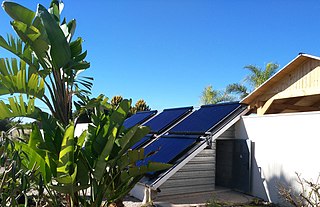
Solar water heating (SWH) is heating water by sunlight, using a solar thermal collector. A variety of configurations is available at varying cost to provide solutions in different climates and latitudes. SWHs are widely used for residential and some industrial applications.
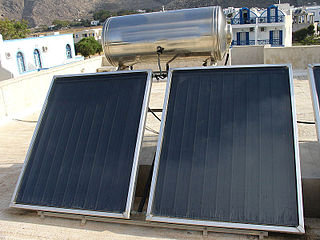
A solar thermal collector collects heat by absorbing sunlight. The term "solar collector" commonly refers to a device for solar hot water heating, but may refer to large power generating installations such as solar parabolic troughs and solar towers or non water heating devices such as solar air heaters.
Thermal shock is a type of rapidly transient mechanical load. By definition, it is a mechanical load caused by a rapid change of temperature of a certain point. It can be also extended to the case of a thermal gradient, which makes different parts of an object expand by different amounts. This differential expansion can be more directly understood in terms of strain, than in terms of stress, as it is shown in the following. At some point, this stress can exceed the tensile strength of the material, causing a crack to form. If nothing stops this crack from propagating through the material, it will cause the object's structure to fail.

Borosilicate glass is a type of glass with silica and boron trioxide as the main glass-forming constituents. Borosilicate glasses are known for having very low coefficients of thermal expansion, making them more resistant to thermal shock than any other common glass. Such glass is subjected to less thermal stress and can withstand temperature differentials without fracturing of about 165 °C (300 °F). It is commonly used for the construction of reagent bottles and flasks as well as lighting, electronics and cookware.
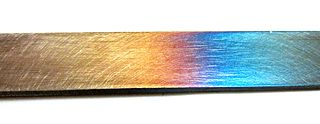
Tempering is a process of heat treating, which is used to increase the toughness of iron-based alloys. Tempering is usually performed after hardening, to reduce some of the excess hardness, and is done by heating the metal to some temperature below the critical point for a certain period of time, then allowing it to cool in still air. The exact temperature determines the amount of hardness removed, and depends on both the specific composition of the alloy and on the desired properties in the finished product. For instance, very hard tools are often tempered at low temperatures, while springs are tempered at much higher temperatures.
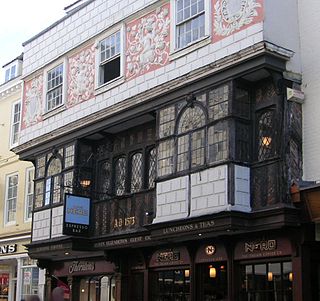
Architectural glass is glass that is used as a building material. It is most typically used as transparent glazing material in the building envelope, including windows in the external walls. Glass is also used for internal partitions and as an architectural feature. When used in buildings, glass is often of a safety type, which include reinforced, toughened and laminated glasses.
Solar air conditioning refers to any air conditioning (cooling) system that uses solar power.

An absorption heat pump (AHP) is a heat pump driven by thermal energy such as combustion of natural gas, steam solar-heated water, air or geothermal-heated water differently from compression heat pumps that are driven by mechanical energy. AHPs are more complex and require larger units compared to compression heat pumps. In particular, the lower electricity demand of such heat pumps is related to the liquid pumping only. Their applications are restricted to those cases when electricity is extremely expensive or a large amount of unutilized heat at suitable temperatures is available and when the cooling or heating output has a greater value than heat input consumed. Absorption refrigerators also work on the same principle, but are not reversible and cannot serve as a heat source.
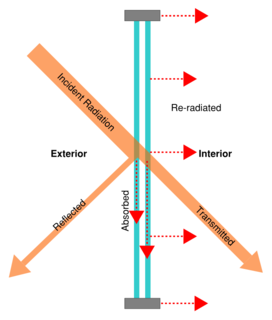
Solar gain is the increase in thermal energy of a space, object or structure as it absorbs incident solar radiation. The amount of solar gain a space experiences is a function of the total incident solar irradiance and of the ability of any intervening material to transmit or resist the radiation.

A solar combisystem provides both solar space heating and cooling as well as hot water from a common array of solar thermal collectors, usually backed up by an auxiliary non-solar heat source.

Glass-to-metal seals are a very important element of the construction of vacuum tubes, electric discharge tubes, incandescent light bulbs, glass encapsulated semiconductor diodes, reed switches, pressure tight glass windows in metal cases, and metal or ceramic packages of electronic components.
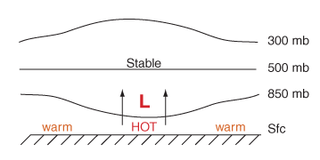
Thermal lows, or heat lows, are non-frontal low-pressure areas that occur over the continents in the subtropics during the warm season, as the result of intense heating when compared to their surrounding environments. Thermal lows occur near the Sonoran Desert, on the Mexican plateau, in California's Great Central Valley, in the Sahara, over north-west Argentina in South America, over the Kimberley region of north-west Australia, over the Iberian peninsula, and over the Tibetan plateau.

Solid is one of the four fundamental states of matter. The molecules in a solid are closely packed together and contain the least amount of kinetic energy. A solid is characterized by structural rigidity and resistance to a force applied to the surface. Unlike a liquid, a solid object does not flow to take on the shape of its container, nor does it expand to fill the entire available volume like a gas. The atoms in a solid are bound to each other, either in a regular geometric lattice, or irregularly. Solids cannot be compressed with little pressure whereas gases can be compressed with little pressure because the molecules in a gas are loosely packed.

Insulating glass (IG) consists of two or more glass window panes separated by a space to reduce heat transfer across a part of the building envelope. A window with insulating glass is commonly known as double glazing or a double-paned window, triple glazing or a triple-paned window, or quadruple glazing or a quadruple-paned window, depending upon how many panes of glass are used in its construction.

















